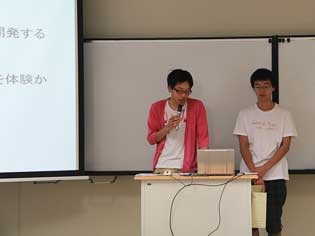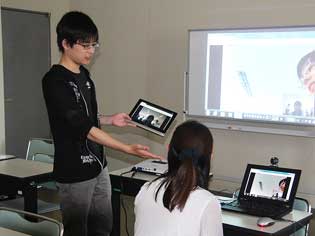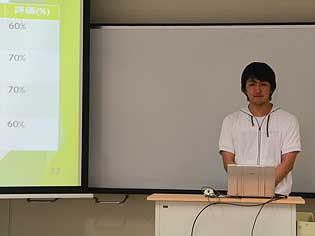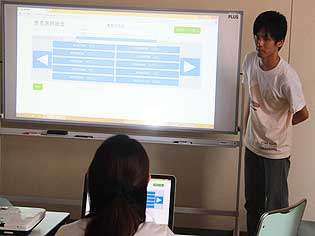On Monday, July 27, 2015, an accomplishment report presentation for the AY 2015 1st semester "Software Studio" was held at the University of Aizu.
"Software Studio" is a course designed for undergraduate students to deepen their understanding of software engineering by actually developing software to meet a clients' needs.
Upon receiving an order from a client, two student teams each work on a different order. Each team starts with a hearing of the client's requests to determine the requirements for the software they will develop. Then they design, develop, and test their new product. Following making a presentation regarding the outline of their working process and the deliverables, they finally deliver their product to the client. Each team has a coach sent from the industry who gives them practical advice on the development process.
Students make weekly progress reports to their instructor and coach, having meetings with their client as needed. They also document each process step and submit these documents as deliverables. Clients also participate in interim and final presentations. There, the students analyze and discuss the quality of deliverables and their working efficiency. This method has been employed since 2009, and the deliverables produced are being used by the clients.
In 1st semester AY 2015, the students in the course developed the two systems indicated below in cooperation with Associate Professor Toshiyuki Takeshige from the Aizu Medical Center Palliative Care Department in order to tackle issues related to palliative care.
- "h2link system" developed by UoA Project Team A (Let's Call)
This system was developed aiming to support patients' home healthcare after being discharged from the hospital by using videophone service on tablets. The system would help patients reduce anxiety and feel secure by letting them have face-to-face talks with doctors and nurses anytime, anywhere. - Aroma Treatment Documentation System developed by UoA Project Team B (Let's Aroma)
When implementing the aroma therapy corresponding to conditions, this system would help medical staff retrieve and analyze data of each patient to provide suitable treatment to different conditions of individual patients, in an effort to upgrade the quality of the entire treatment.
At the final presentation meeting, each team looked back at the project as a whole, discussing their innovations, difficulties, and what they had learned. They also stated that actually developing software within a limited amount of time helped them learn the significance of each step of the development process, and methods for managing those steps. After their talks, they demonstrated the software they had developed.
Students in the "Software Studio" course, will continue to develop software based on client requests.
Comments from students and the instructor
Daiki Hashimoto (4th-year undergraduate, Team A): At first we had difficulty figuring out what functions the client really needed based on their requests. However, in the course of developing the software, we learned that it is important not only to listen to what the client has to say, but also to make our own proposals to the client based on what we had learned and experienced while designing a system. Progress was slow at first due to a lack of communication. But toward the end of the process, we realized it was important for everyone to work together towards the same goal with the same mindset while respecting everyone's individual and abilities.
Masahiro Arai (4th-year undergraduate, Team B): This was my first experience of software development on a large team. I was puzzled by how different it was to working on a large team. That said, the challenge it presented was a great learning opportunity, so it turned out to be a great experience. I hope I can benefit from this experience as I strive to become a better software developer.
Associate Professor Rentaro Yoshioka (*): This semester, we received orders from the palliative care center of a hospital, which was not something our students were familiar with. My students worked hard to understand the situation where to use the software through onsite surveys and hearings. They did a good job devising ways to make the systems user-friendly for the patients and nurses will be using them. They also worked very hard on videophone functions, which require fairly high-level technical skills.


Team A's presentation (left) and demonstration (right)


Team B's presentation (left) and demonstration (right)


